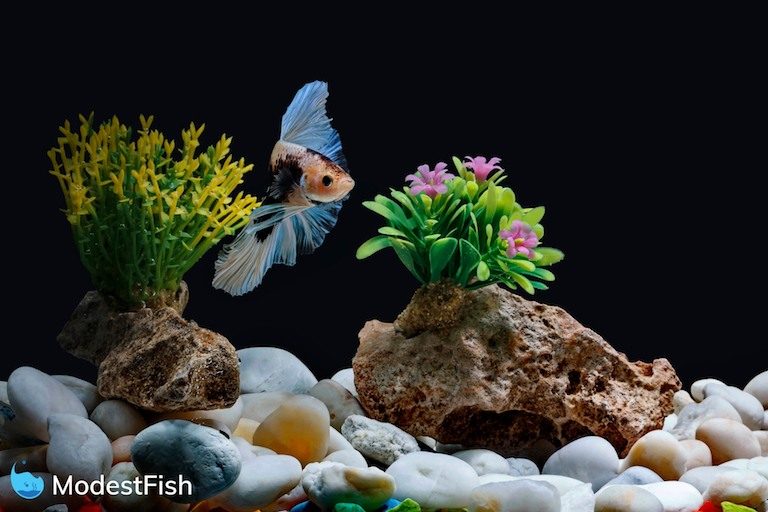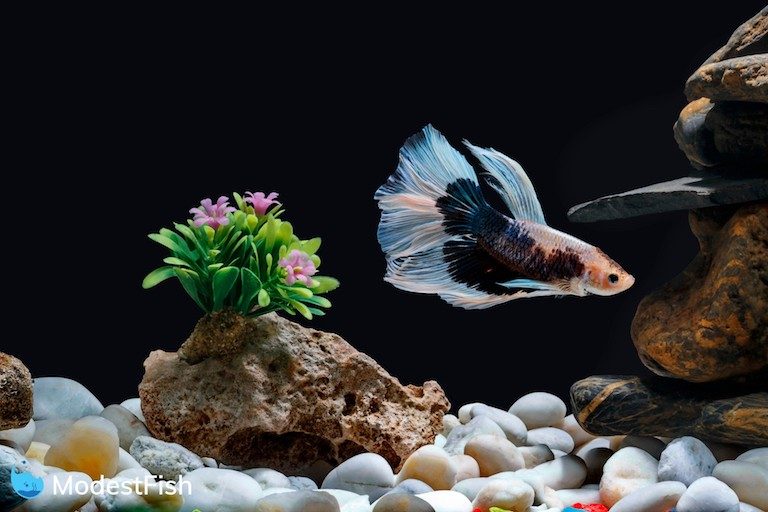Betta fish are awesome, with their vivid colors and glorious fins they deserve a fish tank home that allows them to flourish and live a healthy life.
In this article, you’ll be walked through a simple 3-step guide to setting up the ideal fish tank environment for your Betta.
Let’s get started.
Step 1: Choosing Your Betta Fish Tank And Accessories

Picking Your Betta’s Tank: Size Matters!
Unfortunately, it’s common to see betta’s housed in tiny plastic bowls. The reality is, this results in betta’s becoming sick and living a poor life.
Just because betta’s come from shallow streams doesn’t mean they can be kept in tiny bowls or tanks.
But, that’s not you, you want to own a happy and healthy betta – you want it to thrive.
Your chosen tank should be no-less than 5 gallon – the BIGGER the better.
And 5 gallon tanks are the lowest volume of water needed to easily establish the Nitrogen Cycle. Yes, it’s possible in smaller tanks, but it’s a long and infuriating process.
If you’re still looking for a suitable tank, check out this post for our recommendations.
Do Betta Fish Need A Filter?
Even though bettas come from still waters, you must use a filter. A filter will help keep your tank clean and reduce the amount of harmful bacteria which can lead to disease.a
Betta’s long, flowing fins make it difficult for them to swim in strong currents. So you’ll need to purchase a ‘gentle’ filter.
Check to see if your chosen aquarium comes with a filter. If not, purchase on that’s suitable for your tank. Look for a filter with adjustable flow settings. This way you’ll be sure you can create the optimal currents.
You can see our guide and reviews for Betta fish filters.
Pro Tip: To get the best filtration for your tank, use a filter with a GPH 4 times greater than the size of your tank. GPH stands for gallons per hour, and it’s how much water it will filter every hour. Example, a 5 gallon tank would be a filter with at least 20 GPH.
Do Betta Fish Need A Heater?
Yes, you’ll need to buy a heater because Bettas come from the tropical waters of Thailand.
You should buy a fully submersible heater which can keep the temperature between 78-80 degrees Fahrenheit. And you need to be able to easily monitor the temperature.
If the temperature drops too low, you open the door up to diseases such as Ich. Too high, and you’ll speed up your Betta’s ageing process.
Choose a heater that comes with a thermostat so it’s easy to monitor. And always use a separate thermometer, the readouts from heaters aren’t always accurate.
Never put a heater on a tank under 5 gallons. It can be dangerous to your betta’s health, due to the water temperature warming and cooling too fast.
But that shouldn’t matter… you’re not going to keep your awesome betta in a tank under 5 gallons, are you?
Getting Your Gravel
Betta’s love to swim at all levels, and it’s common you’ll see your betta cruising along the bottom. You’ll need to buy small or smooth gravel so your betta doesn’t hurt itself.
Your gravel will also play an important role in your tank ecosystem. Benefical bacteria will grow on the surface, helping to break down waste.
If you buy gravel made with large pieces of rock, food and waste can get stuck among them and hurt the health of your tank.
Pro Tip: If you’re using live plants, you’ll need two inches of gravel to ensure they root. Fake plants (silk only), you’ll only need one inch.
Plants And Decorations For Your Betta
Betta originate from Thailand, inhabiting rice paddies, slow-moving streams, and large puddles – all shady places with plenty of hiding sports.
Your Betta will love swimming in a tank which contains caves to hide in and plants that provide plenty shady areas. Betta’s enjoy lounging on leaves and have comfortable places to hide and sleep.
It’s important you check ornaments for spots that could snag or tear your Bettas delicate fins. And if you’re going to use fake plants, don’t use plastic ones, use silk plants.
Live plants are always good because they’ll help clean the water and provide your Betta with a natural environment.
You can read our complete guide to Betta fish plants here.
Pro Tip: Your Betta can become bored and depressed easily. It’s a good idea to rearrange the decor when you clean the tank. This will help keep things interesting for your Betta.
Lighting For Your Betta
Your Betta fish is just like you when it comes to lighting. It prefers a schedule: wake up when it’s light, go to sleep when it’s dark.
If your chosen aquarium doesn’t come with its own lighting, I recommend buying one. You’ll be able to provide your Betta with a regular schedule it needs to stay healthy.
LED lights work best because you can control the light intensity. And some will come with automatic timers so you don’t even have to think about it.
Step 2: How To Setup Your Betta’s Tank

1. Preparing And Placing The Aquarium
Start by cleaning out your tank with just water, no soap! Then choose a sport that’s near a window, but not exposed to direct sunlight.
Make sure the surface is nice a sturdy – you may want to consider purchasing a stand designed to hole the weight of your tank. Leave five inches between the aquarium and the wall to allow for the filter.
If you have other pets, you may want to consider placing your Betta in a room they don’t have access to.
2. Install Your Filter
Not all filters are the same, so different types will require different installation methods.
It’s very common that the instructions on filters are terrible. I’d actually recommend using Youtube to find clear tutorials on how to setup your filter.
Make sure you don’t turn your filter on until your tank is filled with water.
3. Add Your Gravel
Give your gravel a thorough rinse with cool running water to remove dust which could clog your filter. Don’t use soap.
Then add your gravel to the tank. Remember, if you’re using real plants, you’ll need at two inches of gravel. For silk plants, one inch will be enough.
4. Set Up Your Plants And Decorations
Ensure the roots of your plants are properly buried in the gravel. And all your decorations are anchored in the gravel, so they won’t come loose.
Pro Tip: To get the best views of your Betta, arrange your plants so the taller ones are at the back of your tank.
5. Fill It Up!
Place a plate on top of your gravel, and pour water on top of the plate to fill your tank. Using a plate with prevent you from displacing the gravel.
During this process you’ll want to check for leaks.
Don’t fill your tank all the way up, leave about an inch and the top. Your Betta’s an anabantoid, meaning it’s able to breathe the same air as you and me by using a unique organ called a labyrinth. Cool, right?
If your Betta is unable to use its labyrinth from time to time, it can be very bad for it’s health. That’s why you leave a gap.
Your Betta is also a surprisingly good jumper, so filling your tank to the brim is risky.
Pro Tip: Remember to remove the plate after you’ve finished!
6. Turn On Your Filter And Install Your Heater
Now that you’ve filled your tank with water, it’s safe to turn on your filter. Make sure the water is circulating gently, soothly, and quietly. You may need to adjust the settings (that’s why is good to buy an adjustable one).
It’s common your heater will come with suction cups to attach it inside your aquarium. Following the instructions, you’ll want to set to temperature so it’s between 78 and 80 degrees Fahrenheit.
Place your thermometer so you can easily monitor the temperature.
Pro Tip: Remember to remove the plate after you’ve finished!
7. Add Neutralizer And Perform A Fishless Cycle
If you’ve filled your tank with tap water, it’ll contain chlorine. So add some neutralizer (follow the products instructions), to remove the chlorine.
This is important because chlorine will stop you from being able to perform the most important step – the fishless cycle. If you don’t do this, when you add your Betta it will die.
A fishless cycle is a humane method of the Nitrogen Cycle.
Beneficial bacteria will become established in your tank and filter media. Allowing ammonia (toxic) to convert to nitrite (toxic), then nitrite to nitrates (non-toxic).
That’s why you can’t skip this step. The beneficial bacteria will supplement your fish’s environment by neutralizing their waste.
For an easy-to-follow guide on how to cycle your tank, read this guide.
Step 3: How To Introduce Your Betta To Its New Tank

1. Buying Your Betta: How To Choose A Healthy Betta
Don’t buy your Betta until your tank have finished cycling. It will just make the whole transition smoother. When your tank is ready, it’s time to go buy your Betta!
Here’s how to tell if a Betta is healthy:
- Bright body and undamaged fins
- The Betta is active and swimming well
- If it’s flaring at another Betta or you
- No deformities (missing eyes, fins, or scales etc.)
- No white dots or fuzzy substances (signs of disease)

Betta Splendens Siamese Male Fighting Fish – Assorted Colors | Live Tropical Aquarium Fish$13.99Buy on Amazon
Last updated on 2020-03-03 / Affiliate links / Images from Amazon Product Advertising API
2. Finally Introduce Your Betta To Its New Tank
Don’t go plopping your new Betta into your tank. It will stress your fish and is likely to end in tears.
You need to acclimatize it to its new environment.
Your Betta is going to come in a bag of it’s own water, which is going to be different from the water in your tank. Keeping the bag closed, float it in your aquarium until the water in the bag reaches the same temperature as your tank.
This can take around one hour, so be patient.
Once the water in your Betta’s bag reaches the same temperature in your aquarium, begin to add small amounts of your tank water into it’s container.
When the majority of the water is from your tank, let your fish swim freely into the tank.
Final Thoughts
Betta fish are fantastic pets and they deserve to be treated right. After going through the correct method of preparing its tank, make sure you care for it properly.
This means, feeding it Betta approve food once a day, being careful not to over feed it. Perform 20% water changes once a week to maintain a healthy environment.
Monitor your the pH, ammonia, and nitrate levels, correcting any issues. And clean your tank regularly. If you’re using a filter, you’ll need to do this once every few weeks.
Follow this guide, and you’ll have a vibrant happy Betta as a friend for years!
Leave a comment, let me know about your Betta tank or if you have any questions or suggestions.

Further Reading: The Betta Handbook$12.63Buy on Amazon
Last update on 2020-03-03 / Affiliate links / Images from Amazon Product Advertising API

Original post here


